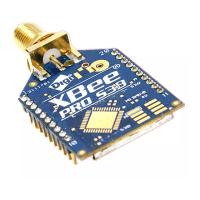Networking methods Delivery methods
XBee®-PRO 900HP/XSC RF Modules
71
Related command: MR
In the same manner as the repeater delivery method, DigiMesh builds on P2MP and repeater modes.
In DigiMesh, broadcasts always use the repeater delivery method, but unicasts use meshing
technologies.
In the DigiMesh network layer, there are additional network layer ACKs and NACKs. Mesh networking
allows messages to be routed through several different nodes to a final destination. DigiMesh
firmware allows manufacturers and system integrators to bolster their networks with the self-healing
attributes of mesh networking. In the event that one RF connection between nodes is lost (due to
power-loss, environmental obstructions, and so on) critical data still reaches its destination due to the
mesh networking capabilities embedded inside the modules. If you disable network ACKs, the
network never heals.
Data transmission and routing
This section provides information on data transmission, routing, throughput, and transmission
timeouts.
Unicast addressing
When devices transmit using DigiMesh unicast, the network uses retries and acknowledgments
(ACKs)for reliable data delivery. In a retry and acknowledgment scheme, for every data packet that a
device sends, the receiving device must send an acknowledgment back to the transmitting device to
let the sender know that the data packet arrived at the receiver. If the transmitting device does not
receive an acknowledgment then it re-sends the packet. It sends the packet a finite number of times
before the system times out.
The MR (Mesh Network Retries) parameter determines the number of mesh network retries. The
sender device transmits RF data packets up to MR + 1 times across the network route, and the
receiver transmits ACKs when it receives the packet. If the sender does not receive a network ACK
within the time it takes for a packet to traverse the network twice, the sender retransmits the
packet.
MAC retries and acknowledgments are used for transmissions between adjacent nodes in the route.
NWK retries and acknowledgments are used across the entire route.
To send unicast messages while in Transparent operating mode, set the DH and DL on the
transmitting device to match the corresponding SH and SL parameter values on the receiving device.
Routing
A device within a mesh network determines reliable routes using a routing algorithm and table. The
routing algorithm uses a reactive method derived from Ad-hoc On-demand Distance Vector (AODV).
The firmware uses an associative routing table to map a destination node address with its next hop. A
device sends a message to the next hop address, and the message either reaches its destination or
forwards to an intermediate router that routes the message on to its destination.
If a message has a broadcast address, it is broadcast to all neighbors, then all routers that receive the
message rebroadcast the message MT+1 times. Eventually, the message reaches the entire network.
Packet tracking prevents a node from resending a broadcast message more than MT+1 times. This
means that a node that relays a broadcast will only relay it after it receives it the first time and it will
discard repeated instances of the same packet.
Route discovery
Route discovery is a process that occurs when:

